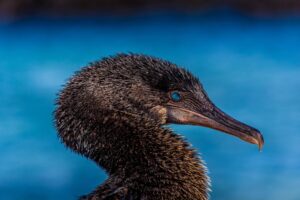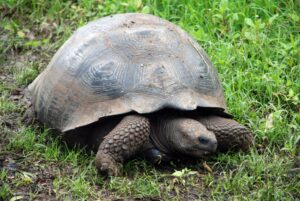Galapagos
Galapagos, also known as the "Enchanted Isles", offers a unique opportunity to view animals in their natural habitat which are completely unafraid of man. The islands, which belong to Ecuador, straddle the Equator about 600 miles off the coast of South America.
Galapagos cruise holidays are our speciality
We have been offering tailor-made trips to the Galapagos for over 35 years.
Our founder David Horwell gained invaluable insight and knowledge into the islands when we became a naturalist guide in the Galapagos in the 1970s.
With this deep understanding of the ecology, wildlife cycles and weather patterns he set Galapagos Adventure Tours, the only travel company solely creating trips to the islands. Since then we have expanded to offer select tours of the whole of Latin America, but Galapagos remains our prime destination.
It is wise to book up well in advance and with a company that knows the islands as intimately as us. Our tailor-made holidays are a truly memorable experience.
A word from our director
“Over thirty-five years ago I landed on an ex-military airstrip in the Galapagos Islands. Baltra island seemed an inhospitable backwater. The cactus-covered lava looked like an alien planet. Why on earth had I come? A few hours later I had sailed on a schooner to a nearby uninhabited islet. The contrast was amazing.
The yacht anchored in a tiny cove of turquoise water. A small dinghy, locally known as a 'panga', dropped us ankle-deep in the cool unpolluted Pacific. Once ashore on a white coral sand beach, a group of playful young sea lions came as if to greet us. Brightly coloured 'Sally Light-foot' crabs scattered over the algae-stained rocks, while dark scaly iguanas stood motionless, like part of the jagged lava. The beach master - a huge bull sea lion - came to investigate the intruders into his domain. When he realised we were no threat, he raised a whisker or two, then disappeared with a splash. A lone hawk hovered above, keeping any eye on the scene totally unafraid of us.
It is the feeling that you are the first person to land that makes each landing so beguiling. Today the islands are less remote, the jet from the mainland takes less than two hours (rather than 5 hours in the old turbo-prop). Bigger and more comfortable yachts take passengers in air-conditioned luxury. Thirty-five years ago a shower was a bucket of seawater on deck and anchors were all pulled up by hand. Happily, despite huge increases in visitors, the animals are just the same, the magic is still there and the boobies carry on dancing...”
– David Horwell
(Founder of Galapagos Adventure Tours and Director of Select Latin America).
Why are the Galapagos so special?
The Galapagos’ isolated location at the meeting place of warm and cold currents have created a truly diverse set of ecosystems which in turn has allowed the wildlife to flourish. Nowhere else on earth can you find such a variety of creatures - flightless cormorants, the only penguins to cross the Equator and giant tortoises that roam the islands. There are many species unique to the Galapagos.
Whilst most of the native creatures are permanent residents of the archipelago some like the waved albatross or green sea turtle return back to their original island to breed after several years of travel. Other marine life – sharks, whales and dolphins use the islands as a refuge in the plankton-rich waters en route to other destinations.
The islands and habitats are as diverse as the wildlife that inhabits it. The larger islands are made of huge volcanoes; others are heavily forested with prickly pear cactus. There are islands created of barren lava flow and others with white sandy beaches, coral and reefs. Each time you land the scenery appears like an alien landscape, no two look alike.
The Galapagos Island’s most famous visitor was of course Charles Darwin in the 19th century. It is here that his first thoughts on evolution were formed. Settlers did not arrive to the islands until the 20th century, and it’s this absence of human contact and predators that have allowed the wildlife to evolve without fear. There is nowhere else on earth where you can observe animals in such close quarters – watching the dance of the blue-footed booby just a few feet away or snorkelling with sharks and turtles. As one of clients recently said on returning from their Galapagos holiday "there's a wonder around every corner."
The Galapagos have been granted World Heritage status and as such many steps are being taken to conserve the habitats and wildlife and only a limited number of tourists can visit. We know the best of the boats available having taken cruises on most of them from small traditional sailing vessels to dive specialist boats to pure luxury yachts that have been chartered by Hollywood film stars. A few islands have hotel options for those who prefer to stay on land.
When to go:
During the hot season between December-March, temperatures range from 25-32°C and can recieve a little rain in the afternoons. It is good for snorkelling. During the cool season May-November the effects of the cool Humbolt current are more pronounced making it drier but cooler 16-22°C, there is often a mist or garua in the mornings.
All our tailor made Galapagos cruise holidays are individually designed, but as a guide we can arrange a 10 day itinerary with 8 days on the islands from £4,500 including flights.
Guides:
Isabela & Western Islands

The largest island on the archipelago with majestic scenery of volcanoes and crater lakes and wildlife including penguins and flightless cormorants
San Cristobal & Eastern Islands

There are many species of birds including boobies, frigates, albatross as well as impressive snorkel sites to enjoy the marine life
Santa Cruz & Central Islands

Sea lions, the Charles Darwin research centre and your chance to see giant tortoises in the wild highlands
Santiago & Northern Islands

Rugged landscapes created from lava flows with sunken craters and tide-pools teeming with marine life waiting to be explored

1. Fernandina
2. Isabela
3. Pinta
4. Santiago
5. Rábida
6. Sombrero Chino
7. Marchena
8. Santa Cruz
9. Floreana
10. North Seymour
11. Baltra
12. Plazas
13. Santa Fe
14. Genovesa
15. Española
16. San Cristóbal

